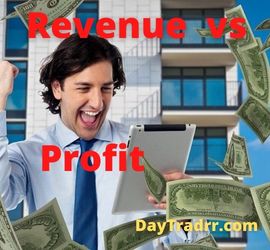Revenue Vs. Profit – Overview
 Revenue vs. profit – what’s the difference? Revenue is income generated through business operations while profit is net income after deducting expenses from earnings. Profit and revenue are two very important numbers to focus on for business owners and stock investors alike. Revenue is the total amount of money the company earns in a given period. Profit is what’s left after expenses have been deducted. In other words, revenue describes income generated through business operations, while profit describes net income after deducting expenses from earnings. Revenue can take various forms, such as sales, income from fees, and income generated by property and rents.
Revenue vs. profit – what’s the difference? Revenue is income generated through business operations while profit is net income after deducting expenses from earnings. Profit and revenue are two very important numbers to focus on for business owners and stock investors alike. Revenue is the total amount of money the company earns in a given period. Profit is what’s left after expenses have been deducted. In other words, revenue describes income generated through business operations, while profit describes net income after deducting expenses from earnings. Revenue can take various forms, such as sales, income from fees, and income generated by property and rents.
However, a company can bring in large amounts of revenue, but there will be no remaining profit if expenses exceed revenue. Revenue refers to the entire amount of money earned through the sale of goods or services connected to the company’s principal business. Profit, also known as net profit or the bottom line, is the amount of money left over after all expenses, debts, extra revenue sources, and operational costs have been deducted. These two phrases are often used interchangeably, so it is important to understand the distinction between revenue vs. profit. Considering this, a corporation might produce considerable revenue while running at a net loss.
Revenue vs. Profit – Key Differences
Revenue
Because it appears at the top of the income statement, revenue is commonly referred to as the top line. The revenue figure is the amount of money a firm makes before any expenditures are deducted. For example, before deducting any expenditures, a service station’s revenue is the money it makes from selling gas, oil, snacks, and drinks. If a company has income through investments or interest income, it is not considered revenue. This is due to the fact that it is not derived from the service station’s operations. Additional sources of revenue and different types of costs are tracked individually.
Profit
On the income statement, profit is referred to as net income. However, most people also know it as the bottom line. Profit is a metric on the income statement that is used to assess a company’s success. However, between the top line (revenue) and the bottom line (net income), there are different profit margins (net profit). The term profit, for example, may appear in the context of gross profit and operational profit. These are the stages that lead to a net profit.
Revenue minus cost of goods sold (COGS) equals gross profit. Cost of goods sold are the direct costs linked to the manufacturing of the products sold by a business. This figure comprises the cost of materials used in the production of a company’s products as well as direct labor expenses. Operating profit is gross profit minus all additional fixed and variable expenditures such as rent, utilities, and payroll that come with running a firm.
Key Differences
When most individuals talk about a company’s profit, they’re talking about net income rather than gross or operational profit. After costs, net profit is what’s left. It’s important to keep in mind that a corporation can generate revenue and income while still losing money. For example, consider revenue vs. profit in a family budget. A household can earn a good salary and still spend more money than it brings in on a monthly basis.
Revenue Vs. Profit – A Closer Look
Revenue generally refers to the money or income earned through operations. Sales are the most common source of revenue for a company, but it can also come from fees, interest, real estate rents, taxes, contributions, grants, investments, and other sources.
Revenue on the Income Statement
Revenue, particularly gross revenue, is the first line on the income statement. As a result, it is commonly referred to as the top line. All sources of revenue earned by the company are lumped together and referred to as gross revenue. For example, gross income or revenue for a manufacturing business would include all products sold, regardless of the cost to make it. Gross revenue is the total amount of money a non-profit receives from fundraising, contributions, grants, and other sources. Revenue can be further divided into operating revenue and non-operating revenue. This helps to distinguish incidental or supplementary sources of income, from core operating activities.
- Operating revenue – The revenue created by a company’s main business operations. For example, day-to-day activities such as selling goods and providing services to customers and clients.
- Non-operating revenue – Non-operating revenue is the money created by the business’s other operations that are carried out concurrently. These are non-recurring in nature and cannot be forecast in terms of whether or not money will be earned. It might include the sale of assets, the selling of scrap, commissions, interest, dividends, and rent, among other things.
Profit on the Income Statement
Profit is a monetary gain most businesses pursue. It is the reward for taking a risk and investing money to start and run a business. Profit is the remaining amount of a company’s revenue after all costs have been deducted. However, there are different categories of profits:
- Gross profit – Revenue minus cost of products sold equals gross profit. The costs of items sold vary by industry, but they generally follow the same basic principle. They are the direct expenses associated with the sale of core products and services. The cost of goods sold for a retail outlet would comprise inventory costs and retail employee payroll hours. The gross margin of a corporation indicates how much it may mark up its goods or services based on the prices it pays to suppliers. Gross profit is calculated by subtracting the cost of goods sold (COGS) from the total revenues
- Operating profit – Next on the list is the operating profit. Consider operating profit to be gross profit less overhead expenses. Most other sorts of operational expenditures are listed as operating expenses, such as rent, administrative wages, and insurance. The operating profit reveals how much money the primary business activity generates.
- Net profit – After all other expenditures have been subtracted, the net profit is what’s left. Taxes, interest expenditures, and one-time things like legal settlements are all included. These costs might fluctuate dramatically from year to year. These other expenditures aren’t related to the fundamental activities of the firm. As a result, they don’t fall within the cost of products sold or operational expenses category. The stock market pays close attention to net profit and its earnings-per-share, or EPS. Knowing that net profit can fluctuate even when gross and operational profit is stable might offer you an advantage over other investors.
Revenue vs. Profit – What Is More Important?
Both are important figures and are closely watched by accountants, company officers, managers, and investors. However, net profit gives a more complete view of a company’s financial health. It accounts for all recurring costs and demonstrates how well a company manages the big picture. Determining a company’s profit automatically considers liabilities and other expenditures, such as wages and the cost of goods sold.
Gross profit is an important metric since it reveals company trends in terms of sales and manufacturing expenses. Gross profit growth, often known as top-line growth, gives crucial information about a company’s health and prospective development. However, it eliminates all fixed and variable expenditures unrelated to production and sales. By itself, gross profit is an incomplete representation of a company’s total profitability and financial health. Therefore, the metric that best illustrates how well the organization is functioning is net income and bottom-line growth.
On a company’s income statement, revenue vs. profit are two closely watched, essential metrics. While revenue is referred to as the top line, profits are referred to as the bottom line. Of course, all available metrics are crucial to consider when making investment decisions. Nevertheless, investors should understand the difference between revenue vs. profit. Revenue is the amount of money a company produces before subtracting its expenditures. However, you must account for all of a company’s expenses, including labor, loans, taxes, and other costs when calculating its profit.
Revenue vs. Profit – Frequently Asked Questions
Can Profit Be Higher Than Revenue?
The top line of an income statement is revenue, as seen at the top of the income statement. The bottom line, on the other hand, is referred to as profit. Because expenditures and obligations are removed, profit is smaller than income. Hypothetically, if a company had absolutely zero expenses, its revenue and profit would be essentially equal.
Is Revenue the Same as Sales?
Sales are revenue are often used interchangeably, so many consider the two terms equivalent. However, revenue refers to the amount of money a company makes overall before expenditures are deducted. Conversely, sales refer to the amount of money the company makes through selling its core goods and services to its consumers. As a result, 0ther sources of revenue and income are not considered.
How Much of Revenue Is Profit?
It depends. After a corporation accounts for expenses, debts, other income, and operational costs, profit is what’s leftover. Sometimes there is nothing left over, in which case there is a negative profit commonly referred to as a loss.
Up Next: What Is the Crowding Out Effect?
 The crowding out effect is an economic premise asserting that government spending competes with, thereby reducing or eliminating private spending. When governments have budget deficits, they usually have to borrow money to cover them. When governments borrow, they compete with everyone else in the economy for the limited quantity of accessible savings. The real interest rate rises as a result of this rivalry, while private investment falls. Crowding out is the term for this phenomenon.
The crowding out effect is an economic premise asserting that government spending competes with, thereby reducing or eliminating private spending. When governments have budget deficits, they usually have to borrow money to cover them. When governments borrow, they compete with everyone else in the economy for the limited quantity of accessible savings. The real interest rate rises as a result of this rivalry, while private investment falls. Crowding out is the term for this phenomenon.
The majority of economists concur that deficit spending is not a problem in and of itself. In reality, during severe recessions, deficit spending may be required. However, most economists understand that deficits and debts may have long-term effects. Because of the lower investment spending, a country’s capital stock will not increase as quickly. As a result, crowding out has the potential to diminish a country’s future productivity.




